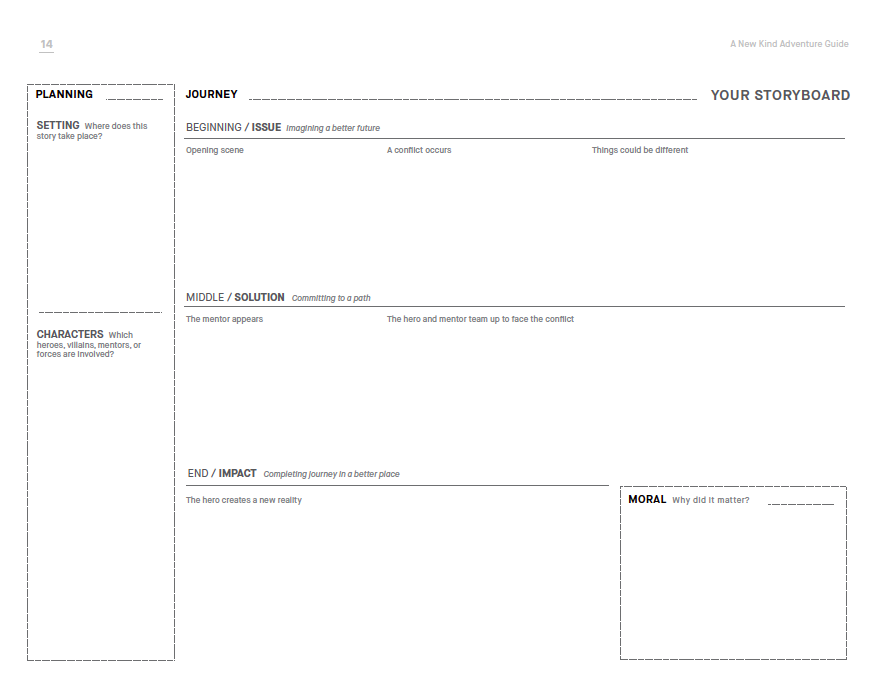Adventure Guide: The Fundamentals of Storytelling for Building Memorable Brands
Prologue
Nothing connects humans like stories. For as long as humans have been communicating, stories have been our path to share, learn, and remember. Today storytelling is one of the most powerful tools we have for building brands. In our hyperconnected digital world, stories create meaning, cut through complexity, and make content persuasive. Whatever the medium—digital,TV, or print—they connect you deeply to your audience.
This guide is designed to help you discover new ways to apply the power of storytelling to your branding, marketing, and advertising efforts. To help you turn the facts you tell about your organization into stories. It doesn’t mean every conversation you have with a new audience starts with “Once upon a time…” But it will give you a few ideas for simple, yet powerful tools you can use to make your messages more memorable.
Chapter 1: Why stories matter for business
When information is unlimited, stories are invaluable.
Every day we experience a staggering amount of information. Stories help us find patterns and meaning in the chaos, so we can remember what’s important. When information is unlimited, stories are invaluable.
Stories align our ideas, connect our facts, and create meaning. Narratives are simply more persuasive—and persuasion is fundamental to business. We persuade customers to buy our products.
We persuade employees to work for our vision. And we persuade the people we talk to every day to believe in us and what we stand for. Why are stories more compelling than facts alone?
- Stories are universal to the human experience. People are naturally wired for stories. Stories are how we experience the world, and how other people help us experience their world.
- Stories are more memorable. There’s a good reason why we can remember plots to movies we saw only once years ago but can’t remember messages in marketing collateral we saw yesterday. Stories stick because they connect with us emotionally.
Telling emotional and memorable stories connects brands to people. Storytelling can be the foundation for brand messages, marketing campaigns, and events. And they can inspire employees to do great work every day.
The best brands stand out by telling compelling stories about what they stand for.
This is why one of the hottest topics in business today is also one of the oldest. Stories are powerful in business because when ideas align to our narratives and tap our emotions—they connect to us at a deeper level. And it’s at that level where we are persuaded to act, purchase, and advocate.
In the following pages we will help you identify the common elements of what makes stories compelling and help you apply them to the messages you share every day.
Chapter 2: Common Elements of a Story
Facts explain what. Stories explain why. And people remember the why.
You already know the facts about your organization. You know what your products or services do. You know your target market. Your competitors. Your business plan. But facts explain what. Stories explain why. And people remember the why.
Think about the great stories you know and love. Star Wars, Harry Potter, The Wizard of Oz. Or the story your grandmother has told you 100 times that never gets old. They all share common elements. How can we leverage these same elements to bring our brands’ stories to life?
We’ll start by exploring elements common to many stories, and how you can apply them to brands.
1. CHARACTERS
Characters have hopes and fears, setbacks and successes. Characters interact with each other and the world. They change over time and they change others around them. Stories have protagonists that move the action forward. And they have antagonists who stand in the way.
Often in marketing communications, we don’t reveal characters. We talk about products and companies rather than talking about people. But humans are social creatures. We relate most to our own experiences and the experiences of others. By making your organization’s stories into human stories, you make them more engaging. Potential customers will visualize themselves using your products or taking action.
Here are the main types of characters you might include in your brand stories:
Heroes
Heroes are often the central characters in your story. Everyone loves heroes. They’re thrust into challenging situations. They face difficult odds. Their imperfections make them human. We get behind their cause and we believe in them. And they find ways, somehow, to succeed in the end.
Heroes are the most important characters in your story because the action revolves around them. Take the time to bring them to life. Let the audience into their world.
Villains
Every hero needs a villain. There’s no Superman without Lex Luthor. No Batman without The Joker. Villains are always ready to throw obstacles in your hero’s way. The villains create the conflict in a story.
Characters are what make stories human, but that doesn’t always mean every character must be human. That’s particularly true with villains. Time, budget, competitors, market forces—to the heroes in a business story, these are villains as destructive as any comic book writer could create.
Mentors
Of all the characters in stories, the mentor is our favorite. Even the best heroes sometimes need help. The mentor is there when the hero needs them most. When our hero is against the wall, when the future is uncertain, when all hope is nearly lost—the mentor steps in. They teach and empower. Then they step back and let the hero take the glory.
Many companies make the mistake of casting themselves as the heroes in their stories. Let the customer be the hero. Your role as the mentor is to guide them.
Example: Character-driven storytelling in practice
Jeep’s “Portraits” Campaign
Imagine a typical car commercial. It starts with a shot of a mountain or a slick cityscape, then a shiny sedan zips around the corner. A voice describes the car’s features. You’ve seen it before. And it’s easy to tune out. Jeep broke through this stereotype and created an ad that puts the emphasis on people, not features.
Jeep’s “Portraits” is a minute-long commercial highlighting the individuals—both famous and obscure—who have connections to the brand. The commercial presents a slideshow of 60 black-and-white photos. Steve McQueen. Marilyn Monroe. B.B. King. Jeff Goldblum. The Terminator. The ad closes with the line, “We don’t make Jeep. You do.” They make their customers and community the heroes.
2. SETTING
Great storytellers not only create characters, they create a world around them. The most compelling setting becomes a character in itself.
Imagine the world your characters live in. Bring their experience to life. What problems do they face every day? Setting is the foundation for imagination. Establishing time and place gives stories structure as action moves from one scene to the next.
Example: Setting-driven storytelling in practice
Jay Z’s Launch of “Decoded”
Jay Z is famous for dotting his lyrics with metaphors and hidden meanings. Fans long to get closer and feel more connected to Jay Z by discovering the locations, characters, and messages behind his cryptic and ingenious lyrics. Setting became a tangible part and a driving factor behind the campaign around the 2010 launch of Jay Z’s memoir, Decoded, which presents the inspiration for many of his song lyrics.
Each of the book’s pages was planted in a real world location that spoke to the content on the page. Some pages were on billboards, while others existed at the bottom of the pool at Miami’s Delano Hotel, wrapped around a vintage Cadillac, on the sides of buildings, and inside the lining of a Gucci jacket. Fans participated in a scavenger hunt for the pages, and clues were distributed through social media. Once fans discovered a page in the wild, they marked it on a digital map. Fans worked together to find pages and eventually complete the book before its launch.
3. CONFLICT
Stories need conflict. Your characters don’t exist in a static world. They want to act, and villains want to act against them.
Conflict gives your hero something to overcome. It adds tension and drama to the story. It draws out the human emotions every person experiences. Think about the hero or heroes in your organization’s story. What problems does your product or service help them overcome?
Example: Conflict-driven storytelling in practice
Chipotle’s “The Scarecrow”
Restaurant branding is often a paradox. Restaurants either serve fast, cheap, and greasy food for those who are on-the-go, or healthy, fresh, and organic food for people who have a little more time and money to spare. Chipotle’s 2013 animated short “The Scarecrow” highlights this conflict and positions the restaurant as an option for those who don’t want to support factory farms, but still need a quick bite to eat.
The film opens with a Scarecrow working at the dark, smoke-filled “Crow Foods Incorporated,” a bleak metaphor for today’s factory farm system. The Scarecrow watches as chickens are pumped with mysterious green fluids and as tubes eject “100% Beef-ish.” A melancholy Fiona Apple cover of “Pure Imagination” plays in the background. But the conflicted opening is resolved with a happy ending, as the Scarecrow returns to his farm and opens a burrito stand, with fresh, locally grown ingredients. Chipotle’s message is to “Cultivate a Better World.”
4. EMOTION
Without emotion, stories would be a (potentially boring) list of steps and facts. Emotion helps stories come alive. Emotion reveals what’s at stake for the characters. And every story needs stakes. What’s the cost of failure for your hero? How does it feel when you’re there to support your hero? How does it feel when they succeed?
Channeling emotion allows brands to connect to what really drives their customer—their wants, needs, and decisions. It helps brands focus on people and why they are buying—not just the products themselves.
Example: Emotion-driven storytelling in practice
Purina’s “Puppyhood”
Animal products provide a perfect platform for emotional messages, because there’s nothing quite like puppy love. Purina’s Puppyhood series evokes “aws” and smiles throughout by focusing on the deeper emotions and stories behind adopting a dog—not just what you need to do when you get one.
The three-minute video shows a man bonding with his new (adorable) puppy. The man teaches the puppy about piano, soccer, 1980s music, and, eventually, the importance of puppy food (featuring Purina’s Puppy Chow, of course.) The campaign goes beyond just cute images. It illustrates the emotional connection between owner and pet. Any animal lover can relate.
5. JOURNEY
Characters in stories always take a journey, and it’s often both an internal and external one. They start in one place and end in another. Characters are changed by their journeys.
The journey can represent what the brand is helping people achieve—both the immediate reward and the long-term benefit. How does the brand change its community?
Example: Journey-driven storytelling in practice
Google’s “Parisian Love”
The video shows how one man’s search terms paint a picture of his journey to finding the love of his life.
The commercial begins with the Google search query “study abroad france” and ends with “how to assemble a crib.” Between these two search paths, the ad subtly illustrates various Google features, showing Google’s role within the character’s journey of meeting, courting, and marrying the love of his life in Paris.
Chapter 3: Storytelling Framework
So how do you turn facts into stories?
Now that you’ve given some thought to different story elements and what makes a compelling story, you can start thinking about how to put your brand’s stories into practice.
There are many different roles storytelling can play in your organization. Stories can be used to highlight a customer journey, showcase the history of your organization, or explain a problem that your product or service addresses.
In the following example, we’ll take you through a framework we use to craft stories. You can use the questions within this framework as a starting point to integrate storytelling into your brand.
The Journey: Your Storyboard
Step 1: Planning (Setting the stage)
- The setting — Where does the story take place? What does your world and the world of your characters look like?
- The characters — Which heroes, villains, mentors, or forces are involved. Which prospect or customer is the hero of your story?
Step 2: Beginning (Imagining a better future)
- Opening scene — What jobs does the hero do?
- A conflict occurs — What pain points does your hero need to overcome?
- Things could be different — What gains does your hero want to achieve? What ideas does your hero have — and what realities do they want to create? What do they want to be different about their current reality?
Step 3: Middle (Committing to a path)
- The mentor appears — How does your organization show up for your hero?
- The hero and mentor team up to face the conflict — In what ways do you solve their pain points? Create their gains? Make their jobs and lives easier and more fulfilling?
Step 4: End (Completing the journey in a better place)
- The hero creates a new reality — What does success look like? And what can the hero focus on now that they’re on the way to a new reality? What’s the next big adventure?
Step 5: Moral (Why did it matter)
- What meaning or insights did you and the customer draw from the experience?
EXERCISE: Telling your Story
- Now that you’ve created your storyboard, think of a specific situation where your organization made a customer successful.
- Now imagine you’re at a conference and a person you’ve met asked what your organization does. Using the storytelling framework, create a 2-3 minute story that you would use to introduce your company.
Conclusion
Stories hold powerful clues. To who you are as an organization, what you are most passionate about, and what you can do that no other organization can.
Look for the themes that are common not only to the story you created during the previous exercise, but that are common to most stories you create. How could you apply storytelling to your current messages? Maybe it’s tweaking the “About Us” section of your website. Maybe you take a more story-driven approach to your banner ads. Or maybe you shift the way you talk about your company during networking events.
If you find that these themes resonate with your audience, they could be potential building blocks to your broader brand story. To truly discover your foundational brand story, we suggest taking a deeper look. Engage your community—both inside and outside the company. What stories do they tell about working with you? What do they want from you in the future? Through this research, and through a collaborative journey, you can discover the story that is uniquely yours and use it to chart a path to the future.
Thanks so much for reading this guide.
Visit our work page to learn more about how we use storytelling to help our clients. Or if you’re interested in a personalized workshop to equip your team with the tools and inspiration to put storytelling concepts into practice, check out our workshops offering.
Have a project you’d like to discuss? We’d love to hear from you.
Until next time, happy adventuring.




